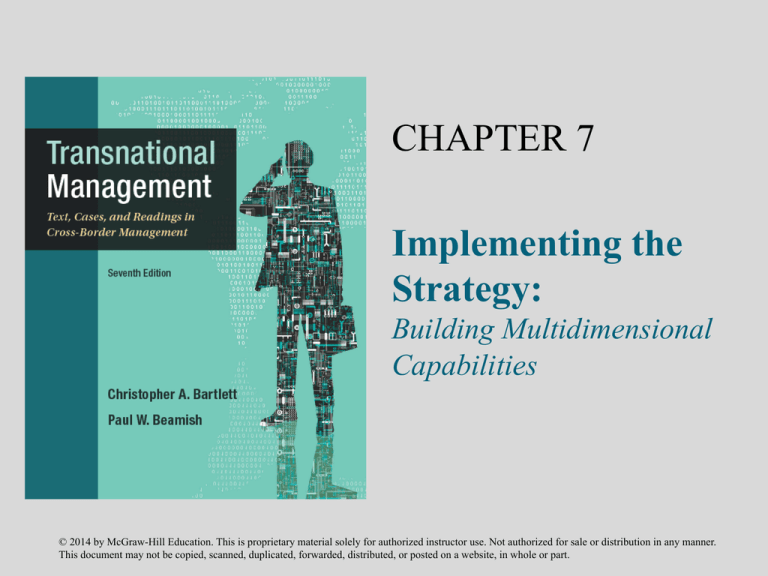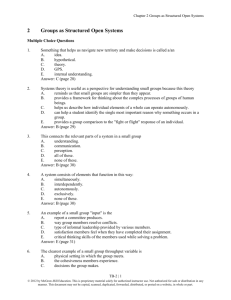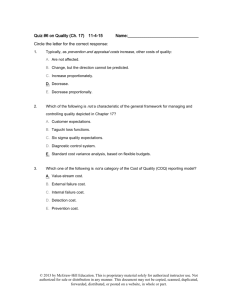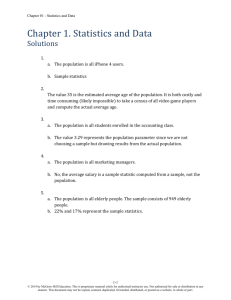CHAPTER 7 Implementing the Strategy
advertisement

CHAPTER 7 Implementing the Strategy: Building Multidimensional Capabilities © 2014 by McGraw-Hill Education. This is proprietary material solely for authorized instructor use. Not authorized for sale or distribution in any manner. This document may not be copied, scanned, duplicated, forwarded, distributed, or posted on a website, in whole or part. Introduction to Implementing Strategy Prior chapters delineated strategies to develop a transnational organization that: Develops global efficiency and competitiveness Creates worldwide innovation and learning Establishes multinational responsiveness This chapter illustrates how to cope with the main challenges when implementing strategies. © 2014 by McGraw-Hill Education. This is proprietary material solely for authorized instructor use. Not authorized for sale or distribution in any manner. This document may not be copied, scanned, duplicated, forwarded, distributed, or posted on a website, in whole or part. 7-2 The Challenge Facing MNEs Today Trying to implement third-generation strategies… …through second-generation organizations… …with first-generation managers Thus it is important to understand how transnational companies define managers’ roles and responsibilities. © 2014 by McGraw-Hill Education. This is proprietary material solely for authorized instructor use. Not authorized for sale or distribution in any manner. This document may not be copied, scanned, duplicated, forwarded, distributed, or posted on a website, in whole or part. 7-3 Three Key Management Roles in the Transnational Company The Global Business Manager The Worldwide Functional Manager The Country Subsidiary Manager But other roles also starting to emerge e.g. the Global Account Manager © 2014 by McGraw-Hill Education. This is proprietary material solely for authorized instructor use. Not authorized for sale or distribution in any manner. This document may not be copied, scanned, duplicated, forwarded, distributed, or posted on a website, in whole or part. 7-4 Global Business Manager Responsibilities Develop global efficiency and competitiveness Roles Global business strategist Architect of asset & resource configuration Cross-border coordinator © 2014 by McGraw-Hill Education. This is proprietary material solely for authorized instructor use. Not authorized for sale or distribution in any manner. This document may not be copied, scanned, duplicated, forwarded, distributed, or posted on a website, in whole or part. 7-5 Role as Global Business Strategist Incorporate perspectives and interests of geographic and functional managers Keep consistency of business strategy with corporate strategy Reconcile different views and prepare an integrated strategy © 2014 by McGraw-Hill Education. This is proprietary material solely for authorized instructor use. Not authorized for sale or distribution in any manner. This document may not be copied, scanned, duplicated, forwarded, distributed, or posted on a website, in whole or part. 7-6 Role as Architect of Asset and Resource Configuration Oversee the worldwide distribution of key assets and resources Shape the future configuration by leveraging existing resources and capabilities Link resources and capabilities in a configuration that resembles the integrated network form © 2014 by McGraw-Hill Education. This is proprietary material solely for authorized instructor use. Not authorized for sale or distribution in any manner. This document may not be copied, scanned, duplicated, forwarded, distributed, or posted on a website, in whole or part. 7-7 Role as Cross-Border Coordinator Decide on sourcing pattern Build on the most capable national operations and capitalize on locations of strategic importance Organize cross-border transfer processes Direct central control: for products of high strategic importance Develop internal quasi-markets: for commodity-like products © 2014 by McGraw-Hill Education. This is proprietary material solely for authorized instructor use. Not authorized for sale or distribution in any manner. This document may not be copied, scanned, duplicated, forwarded, distributed, or posted on a website, in whole or part. 7-8 Worldwide Functional Manager Responsibility Provide support to line managers, particularly by diffusing innovations and transferring knowledge on a worldwide basis Roles Worldwide intelligence scanner Cross-pollinator of “best practices” Champion of transnational innovation © 2014 by McGraw-Hill Education. This is proprietary material solely for authorized instructor use. Not authorized for sale or distribution in any manner. This document may not be copied, scanned, duplicated, forwarded, distributed, or posted on a website, in whole or part. 7-9 Worldwide Intelligence Scanner Capture and transmit leading-edge information across national boundaries in order to track the development and make appropriate adjustments Establish functional specialist information channels to link local technologists, marketers and product experts © 2014 by McGraw-Hill Education. This is proprietary material solely for authorized instructor use. Not authorized for sale or distribution in any manner. This document may not be copied, scanned, duplicated, forwarded, distributed, or posted on a website, in whole or part. 7-10 Cross-Pollinator of “Best Practices” Identify and evaluate leading-edge practices Take initiatives that will expose others to the new ideas Informal contacts Formal reviews Cross-unit visits and transfer © 2014 by McGraw-Hill Education. This is proprietary material solely for authorized instructor use. Not authorized for sale or distribution in any manner. This document may not be copied, scanned, duplicated, forwarded, distributed, or posted on a website, in whole or part. 7-11 Champion of Transnational Innovation Locally leveraged Identify local innovations that have applications elsewhere by scanning the company’s worldwide operations Globally linked Fully exploit the company’s access to worldwide information and expertise by linking and leveraging intelligence sources with internal centers of excellence © 2014 by McGraw-Hill Education. This is proprietary material solely for authorized instructor use. Not authorized for sale or distribution in any manner. This document may not be copied, scanned, duplicated, forwarded, distributed, or posted on a website, in whole or part. 7-12 Geographic Subsidiary Manager Traditional role Source of sales and profits Access to local factors of production Leverage parent company assets and resources New role Bicultural Interpreter National defender & advocate Frontline implementer of corporate strategy © 2014 by McGraw-Hill Education. This is proprietary material solely for authorized instructor use. Not authorized for sale or distribution in any manner. This document may not be copied, scanned, duplicated, forwarded, distributed, or posted on a website, in whole or part. 7-13 Role as Bi-Cultural Interpreter Interpret host country environment for corporate management Communicate the corporate strategies to local employees Causes of Failure Upward communication Poor receptivity of HQ management l Blocked HQ/Subsidiary Channels of Communication l Limited Sensitivity or Understanding at the Subsidiary HQ l Downward communication Weak Connections or Support at HQ l Limited Understanding of Corporate Strategy, Priorities l Lack of Credibility within the Subsidiary SUB. CM HQ l SUB. CM © 2014 by McGraw-Hill Education. This is proprietary material solely for authorized instructor use. Not authorized for sale or distribution in any manner. This document may not be copied, scanned, duplicated, forwarded, distributed, or posted on a website, in whole or part. 7-14 Role as National Defender and Advocate Defend need for national responsiveness Advocate for role of subsidiary within the global operations Causes of Failure CM unwilling or unable to act as a strong advocate or defender of subsidiary interests Structural or cultural blocks that prevent CM from gaining access and influence in corporate decision-making process HQ Business Perspective Functional Perspective B Geographic F G Perspective Subsidiary Transnational decision process requires multi-dimensional perspectives; implies that CMs access and influence in process © 2014 by McGraw-Hill Education. This is proprietary material solely for authorized instructor use. Not authorized for sale or distribution in any manner. This document may not be copied, scanned, duplicated, forwarded, distributed, or posted on a website, in whole or part. 7-15 Role as Frontline Implementer of Strategy Convert strategic plans into actions for subsidiaries Causes of Failure Organizational or managerial inflexibility prevents diversity and changeability of subsidiary roles CM unable to make the complex trade-offs and compromises required Parochialism in subsidiary due to inappropriate systems or inflexible managers © 2014 by McGraw-Hill Education. This is proprietary material solely for authorized instructor use. Not authorized for sale or distribution in any manner. This document may not be copied, scanned, duplicated, forwarded, distributed, or posted on a website, in whole or part. 7-16 Pressures and Constraints on Country Manager MNC Internal Motivations Organization Structure Corporate & Systems Strategy Host Governments Objectives, Policies National Constituent Interests (Employees, Consumers, Unions) Host Country Interests Local Norms & Values Country Manager Personal Values Internal Norms & Values National Competitor’s Actions Global Competitive Activity Local Market & Industry Structure Global Competitive Environment © 2014 by McGraw-Hill Education. This is proprietary material solely for authorized instructor use. Not authorized for sale or distribution in any manner. This document may not be copied, scanned, duplicated, forwarded, distributed, or posted on a website, in whole or part. 7-17 The Many Hats of the Country Manager Pioneer Role: Define the territory: market structure, customer needs Establish the base camp: make contacts, develop relationships Trader Role: Build profitable operations: base camp, trading post; control expenses, manage pricing Develop local resources: contribute to overall strategy Intelligence Role: Analyse the environment: intelligence on competitors, technology, market trends Develop innovative ideas and capabilities as input to strategy Quarterback Role: Confer with HQ coaches to defend, and advocate the field view Motivate team to achieve results Maintain entrepreneurship, creativity and drive © 2014 by McGraw-Hill Education. This is proprietary material solely for authorized instructor use. Not authorized for sale or distribution in any manner. This document may not be copied, scanned, duplicated, forwarded, distributed, or posted on a website, in whole or part. 7-18 Skills & Qualifications of the Country Manager Entrepreneurial skills: Innovator & Opportunist Administrative Skills: Strategic skills: Country Manager Creative Analyst Executive Skills: Controller & Manager Organizational Leader Personnel Implications: Need CMs with different strengths at various stages of development; But in a mature subsidiary, the CM must have all of these characteristics. © 2014 by McGraw-Hill Education. This is proprietary material solely for authorized instructor use. Not authorized for sale or distribution in any manner. This document may not be copied, scanned, duplicated, forwarded, distributed, or posted on a website, in whole or part. 7-19 Top Level Corporate Management Provide long-term direction and purpose Clarity: simplicity, relevance, reinforcement, etc. Continuity: commitment to direction and purpose Consistency : shared by all Leverage corporate performance Control systems based on supporting actions of managers, not directing them Coordinate and legitimize diverse perspectives Ensure continuous renewal Ensure an external orientation Develop a questioning attitude Legitimize new initiatives Help the organization embrace, not deny, complexity © 2014 by McGraw-Hill Education. This is proprietary material solely for authorized instructor use. Not authorized for sale or distribution in any manner. This document may not be copied, scanned, duplicated, forwarded, distributed, or posted on a website, in whole or part. 7-20



